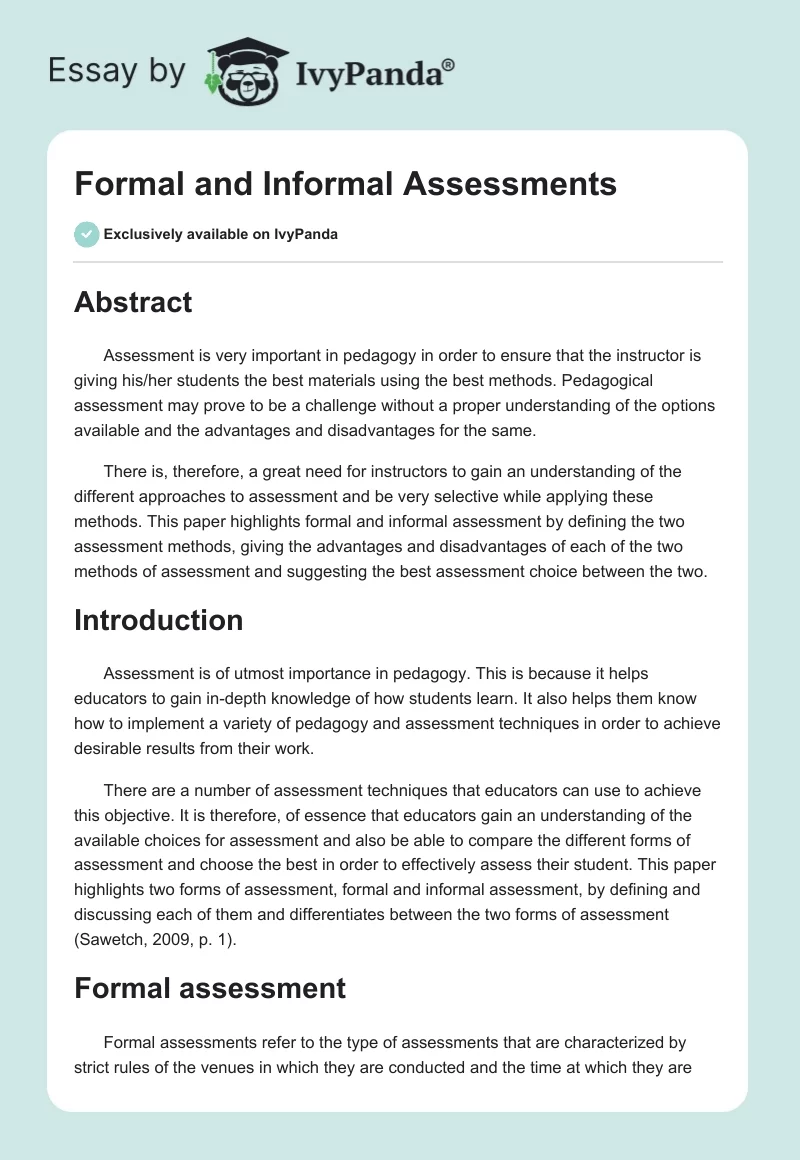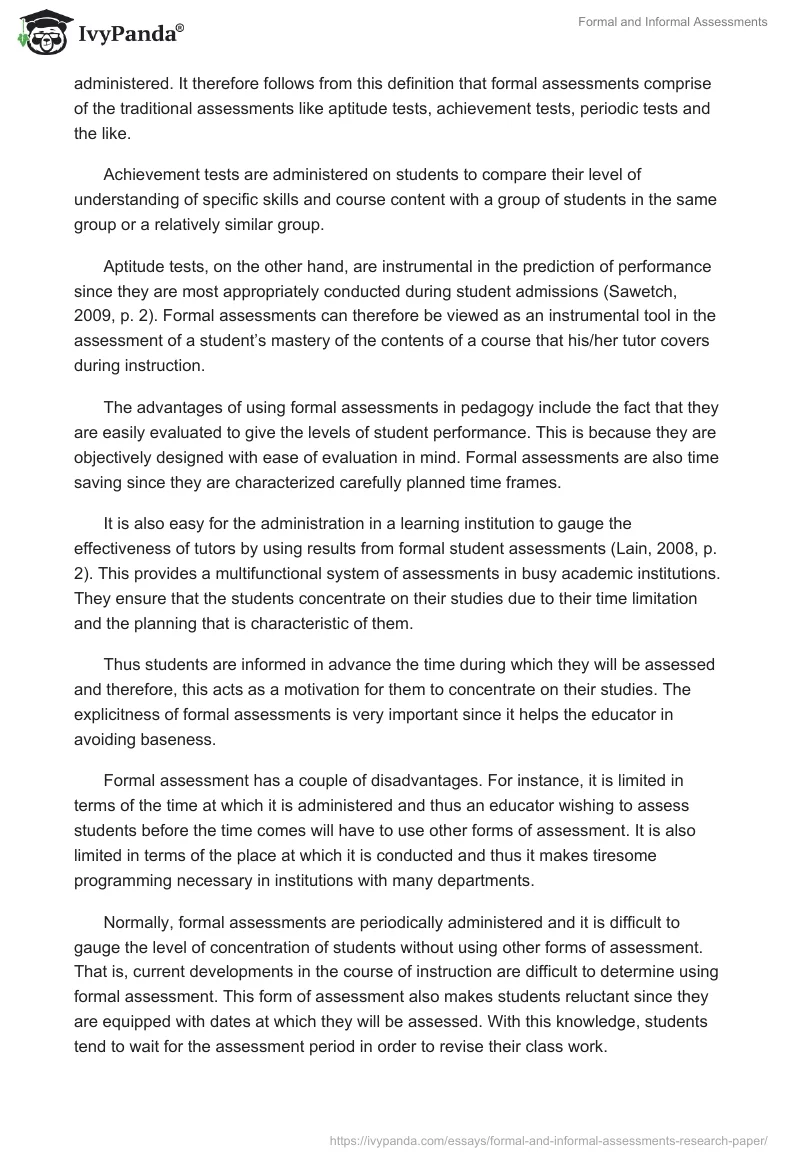Abstract
Assessment is very important in pedagogy in order to ensure that the instructor is giving his/her students the best materials using the best methods. Pedagogical assessment may prove to be a challenge without a proper understanding of the options available and the advantages and disadvantages for the same.
There is, therefore, a great need for instructors to gain an understanding of the different approaches to assessment and be very selective while applying these methods. This paper highlights formal and informal assessment by defining the two assessment methods, giving the advantages and disadvantages of each of the two methods of assessment and suggesting the best assessment choice between the two.
Introduction
Assessment is of utmost importance in pedagogy. This is because it helps educators to gain in-depth knowledge of how students learn. It also helps them know how to implement a variety of pedagogy and assessment techniques in order to achieve desirable results from their work.
There are a number of assessment techniques that educators can use to achieve this objective. It is therefore, of essence that educators gain an understanding of the available choices for assessment and also be able to compare the different forms of assessment and choose the best in order to effectively assess their student. This paper highlights two forms of assessment, formal and informal assessment, by defining and discussing each of them and differentiates between the two forms of assessment (Sawetch, 2009, p. 1).
Formal assessment
Formal assessments refer to the type of assessments that are characterized by strict rules of the venues in which they are conducted and the time at which they are administered. It therefore follows from this definition that formal assessments comprise of the traditional assessments like aptitude tests, achievement tests, periodic tests and the like.
Achievement tests are administered on students to compare their level of understanding of specific skills and course content with a group of students in the same group or a relatively similar group.
Aptitude tests, on the other hand, are instrumental in the prediction of performance since they are most appropriately conducted during student admissions (Sawetch, 2009, p. 2). Formal assessments can therefore be viewed as an instrumental tool in the assessment of a student’s mastery of the contents of a course that his/her tutor covers during instruction.
The advantages of using formal assessments in pedagogy include the fact that they are easily evaluated to give the levels of student performance. This is because they are objectively designed with ease of evaluation in mind. Formal assessments are also time saving since they are characterized carefully planned time frames.
It is also easy for the administration in a learning institution to gauge the effectiveness of tutors by using results from formal student assessments (Lain, 2008, p. 2). This provides a multifunctional system of assessments in busy academic institutions. They ensure that the students concentrate on their studies due to their time limitation and the planning that is characteristic of them.
Thus students are informed in advance the time during which they will be assessed and therefore, this acts as a motivation for them to concentrate on their studies. The explicitness of formal assessments is very important since it helps the educator in avoiding baseness.
Formal assessment has a couple of disadvantages. For instance, it is limited in terms of the time at which it is administered and thus an educator wishing to assess students before the time comes will have to use other forms of assessment. It is also limited in terms of the place at which it is conducted and thus it makes tiresome programming necessary in institutions with many departments.
Normally, formal assessments are periodically administered and it is difficult to gauge the level of concentration of students without using other forms of assessment. That is, current developments in the course of instruction are difficult to determine using formal assessment. This form of assessment also makes students reluctant since they are equipped with dates at which they will be assessed. With this knowledge, students tend to wait for the assessment period in order to revise their class work.
This is despite the fact that the formal assessments make the students study each course attentively due to the inevitability of formal assessments after assessment dates have been given to them (Lain, 2008, p. 2).
The fact that students know in advance that they are to be assessed is disadvantageous to formal assessments since it could make good students to be stressed. This may make them perform poorly having understood the course well. The knowledge could also make poor students cram and perform impressively without having understood the course well.
Informal assessment
Informal assessments can be defined as the type of assessments that do not have limitations regarding the place and time at which they are conducted. From this definition, it can be deduced that informal assessments consist of everyday non-standard forms of assessment like oral interviews, performance assessments, checklists, games and the like. Thus informal assessments involve the classroom activities in which students actively participate (McAlpine, 2008, p. 7).
The most common of the types of informal assessment is performance assessment which is used to evaluate student progress, their understanding of objectives of the course etc. Another example of an informal form of assessment is a checklist which is prepared as a number of objectives that must be met by the end of the course. The tutor continually assesses the students using other forms of informal assessments to ensure fulfillment of checklist objectives.
The obvious advantage of informal assessments is the fact that tutors are responsible for choosing the time and place at which they are to be conducted without much limitation. This implies that they are conducted as need arises and thus their use is convenient. Another advantage of informal assessment methods is that they are designed by the teacher handling the specific course and the decision to administer them or not is his/hers.
This means that they appropriateness to the dynamics of course content is perfect and thus they achieve desirable effects. Additionally, most forms of informal assessment are time saving and thus tutors apply them whenever need arises without the fear of them consuming much of class time. Informal assessment is mostly applicable in situations where a tutor wishes to track the level with which his/her students understand class room lessons progressively.
It is therefore advantageous for continuous assessment to ensure that students are on track and make necessary changes to tutoring methods in a bid to ensure that students get the best out of class room lessons (McAlpine, 2008, p. 8). Additionally, most informal assessment methods improve communication between the tutor and the students and therefore the achievement of their core objective of focusing on fulfilling objectives at the end of the course is easy.
Individual informal assessment methods also have their strengths. For instance, performance assessments are motivating due to the positive approach towards assessment. That is, they consider the strengths of a student and do not consider weaknesses during the assessment. Due to the unpredictability of informal assessments, the stress associable with knowing that one is to be assessed is reduced and thus students may perform well. However, this may also make good students fail to shine.
Informal assessments have, arguably, more disadvantages than formal assessments. For instance, their validity is subject to approval by people who are experts in the subject and thus they are only appropriately applied in planning classroom work. That is, they are considered to be unreliable by other parties like the administration who may wish to know the progress teachers and students are making.
Informal assessment is also subject to misevaluation since some of the techniques used in informal assessment are structured such that, students do not know they are being assessed. This is unlike in formal assessment where the students are aware they are being assessed and the methods used to assess them will make the teacher accurately gauge their understanding of the course. Informal assessments are also subject to more bias than formal assessments since they are casually conducted and some of them lack evidence.
This is because, unlike in formal assessment, informal assessment is characterized by lack of data that supports the decisions made during the assessment. An example of the latter is interviews conducted by the teacher in which an educator will hardly avoid bias.
This occurs due to the possibility of the teacher to be having stereotypes and prejudices which make him/her form a biased opinion unknowingly. When using informal assessment, it is difficult for teachers and parents to compare students with their peers in other schools and/or classes (Lain, 2008, p. 3). On the other hand, this objective is easily achieved in formal assessment.
Due to the stated disadvantages of informal assessment, the method should only be used if it is more applicable than formal assessment in the given circumstances. Otherwise, it should always be used in conjunction with formal assessment.
Conclusion
Although formal assessment is considered to be more advantageous than informal assessment, it is of essence to incorporate both types of assessment in the same course. This is because the two types of assessment are complementary and substitutionary at the same time. For instance, while formal assessment is instrumental in overall assessment at the end of the course, informal assessment is a very important part of diagnostic and formative assessments.
This is one of the examples of how the two assessment types are complementary. An example of their ability to act as substitutes is the fact that at the end of the course, formal or informal assessment can be used depending on the accuracy of assessment desired. For this reason, a balanced combination of formal and informal assessment methods will achieve good results if applied in a specific course.
The choice of which type of assessment to use may also be made depending on the nature of the course or the students attending the course. In a case where students are expected to have high levels of assessment-related stress, it will be wise to use informal assessment approaches (Lain, 2008, p. 1). In a case where students lack motivation and there is need to motivate them, it will be wise to use formal assessment due to its characteristic motivational effects on students.
As evidenced in this paper, the selection of an appropriate assessment plan is very important in pedagogy. It is thus advisable that educators know the available types and approaches of assessment together with their respective advantages and disadvantages in order to ensure that their choice of assessment methods is reliable.
Reference List
Lain, S. (2008). Formal and Informal Assessments. Web.
McAlpine, M. (2008). Principles of Assessment. Web.
Sawetch, M. (2009). Formal and informal classroom assessments. Web.


